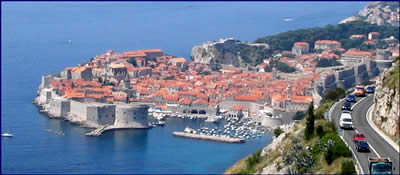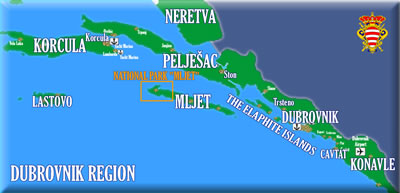| In the far south of the arc that forms Croatian soil, located
on the thin coast strip between the high hills and the calmness
of the Adriatic sea lies a stone white city: Dubrovnik.
 Its
high walls and bastions stand proud above the clear blue sea
boasting to the lush green Lokrum island ranged only hundreds
of meters from the walls. Archaic looks and the unprecedented fairytale
appearance never leave you while roaming the ancient city, the
very reason for Dubrovnik to be a World Heritage site. Its
high walls and bastions stand proud above the clear blue sea
boasting to the lush green Lokrum island ranged only hundreds
of meters from the walls. Archaic looks and the unprecedented fairytale
appearance never leave you while roaming the ancient city, the
very reason for Dubrovnik to be a World Heritage site.

Counting only about 30 000 people Dubrovnik is the cultural and
social centre of the region, the County of Dubrovnik-Neretva,
and Croatian most famous city. The extent of the County of Dubrovnik-Neretva
roughly corresponds to the boundaries of the proverbial Dubrovnik
Republic, the aristocratic maritime republic that excelled in
culture, architecture, arts, and sciences for five centuries until
its demise in the 19th century.

Warm Mediterranean climate, cultural abundance, and natural
beauty of the region are only a few of the points that make Dubrovnik
an appealing destination.
Average
yearly temperature for Dubrovnik is 17°C (63°F),
or 10°C (50°F) for winter period and 26°C (79°F)
for summer period. The summers are long and dry with plenty
of sunshine while the winters are gentle and mild.
All along the Dubrovnik coast, the
sea is wonderfully blue and clear. During the summer
average sea temperature is above 21°C
(70°F).
Throughout centuries Dubrovnik always depended on the sea
so it's no surprise that fishing, seamanship, and sea cuisine are
an essential part of local culture and come almost like second
nature to the local population. The people of Dubrovnik, being
proud and hospitable, will assist you in any situation, tell you
stories of their city and of the sea. Most of the locals talk at
least one foreign language.
Vegetation in the region is typical, mostly Mediterranean,
and is a result of hundreds of years of human influence. As suited
for a merchant harbour city, Dubrovnik mariners traveled
far and wide bringing home many tropical and sub-tropical
cultures, thus creating
an interesting mixture of plant life. Today, you can enjoy in
the sight of citrus and apple trees, palms and agaves alongside
pine and olive trees, and other various beautiful flowers and shrubs
growing in many gardens, parks, and city's green surfaces. |